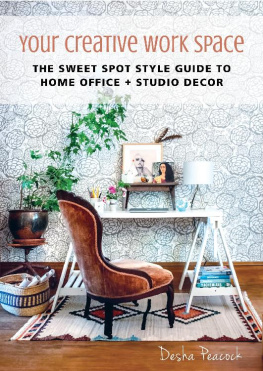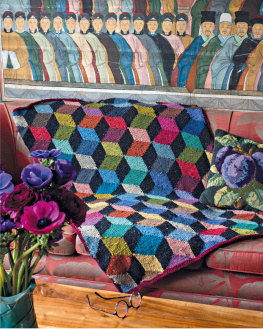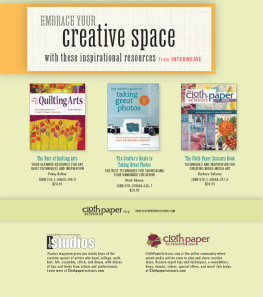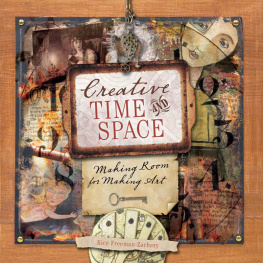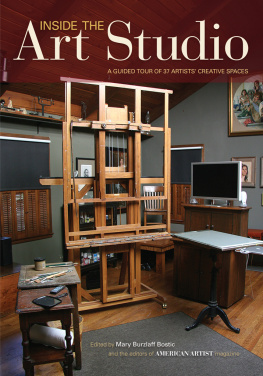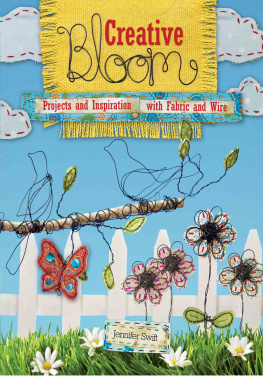Do you dream of having a studio of your own, a place where you can think, create, make a mess, or even teach?
Maybe you have grand plans for a spacious room outfitted with big north-facing windows, huge tables for spreading out your supplies, and even a sink for rinsing out brushes or dyeing fabric. Perhaps you long for a cozy nook where you can play with your materials whenever you like without having to put everything awaya creative oasis amid the demands of family and day jobs.
Whether you have the resources to hire an architect and a crew to build the studio of your dreams or you just have four square feet to call your own, Inside the Creative Studio will give you the inspiration and ideas you need to make your dream come true.
The artists who have opened their studio doors to you in this collection come from all walks of life and areas of art. Some make a living selling what they create. For others, creating is a pastime they cant live without. Their studios range from freestanding, fully equipped showplaces to spare bedrooms turned into creative havens to closets outfitted as craft roomsand everything in between.
Some artists like their studios neat and tidy; others thrive on a jumble of textures and colors. Some haunt flea markets and fill their creative spaces with vintage finds. Others like their environment to be sleek, modern, and spare.
What makes a good studio? At minimum, a studio is any place that inspires you and allows you to work on your art or craft in a safe and efficient manner. If youre a knitter, you may just need a comfy couch and baskets full of yarn. If you like to draw, a sketchpad, a light source, and your pencils may suffice. Quilters and assemblage artists tend to need space to spread out and different kinds of light sources.
Every studio in this book is different, and yet they all have one thing in common: they meet the needs of the artist who works and plays there.
And one other thing: they were all chosen for their potential to inspire you to create the studio youve always wanted.
CATE COULACOS PRATO
Studios magazine editor


As I ascend the stairs to my studio, I leave the hustle and bustle of the world behind and enter a creative wonderland.
MARGIE WOODS BROWN

Not for nothing did Virginia Woolf state that to be creative, a woman needs a room of her own. Even today, when many women have their own incomes, a room dedicated to pursuing ones creative passions can be hard to come by. It isnt always a matter of not having the square footage either. While men have always had their workshops and garages, women tend to think of a space dedicated to their creativity as an indulgence.
Thats why having a studio is so important to any artists life: by virtue of its existence, a studio proclaims that your creative life exists, and it matters.
Is it any wonder, then, that artists use words such as sanctuary, haven, and dream come true to describe their studios? Theyve recognized that their creativity is sacred and deserves its own space. Learn from the artists in the pages that follow how they got their studios and how you can get a room of your own, too.

By Mary Hettmansperger

peru, indiana
Having been an artist for most of my life , I have learned that one of the most important aspects of tapping into creativity is having an inspiring space to work in. This does not mean that I have always had the luxury of working in a fabulous studio. I have worked on my lap, at the kitchen table, in my basement, at many a tennis match watching kids play, and in a downtown studio loft.

maryhetts.com
In every case, changing spaces, moving, evolving, and growing have brought new adventures, challenges, and ideas for that ultimate studio space. The benefit to working in temporary places was that it allowed me to have a constant change of scenery and stimuli. But of course, the downfalls were many.
When it finally came time to build and create my studio space, I felt I was sincerely ready and glad I had not done it any sooner. Having a variety of studio experiences gave me time to really decide where I was going to build and what I wanted and needed. Much like my artwork, my concept of what I wanted in a studio evolved, and when it came time to build, the requirements had also changed.
So I began. I started by finding a local contractor who would work from my drawings. I wanted an all-metal building on a concrete slab. This type of building made the project very affordable, and the building would be easy to maintain. After having my studio in a loft downtown for several years, I knew I did not want any stairs in my studio. Because we built it on our farm, I was able to spread out on one level and didnt have to pay extra for the land. My husband and I did a lot of the work ourselves, and I hired local subcontractors, saving even more money. I wanted the studio to be as green as possible, so that was a consideration in how I approached many aspects of the space. Simple things were important, such as adding a two-flush toilet and placing the main lighting windows high on the walls to allow me to have light without losing wall space. The ceilings are ten feet high with extra insulation in the walls and ceiling. I have open ductwork to avoid any heat/air loss and use an electric heat pump to save energy. Eventually, my plan is to supplement the power by adding windmills.



